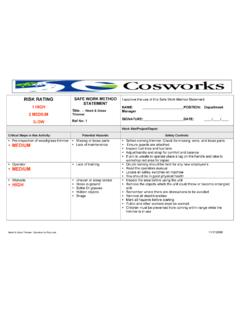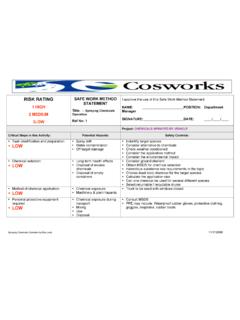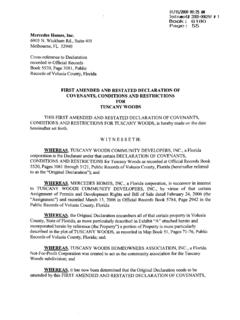Transcription of SAFE WORK METHOD STATEMENT – Part 1 …
1 safe work METHOD STATEMENT part 1 EARTHWORKS. Personal Protective Equipment Foot Hearing High Head Eye Face Hand Protective Breathing Protection Protection Visibility Protection Protection Protection Protection Clothing Protection Day Operations Normal Requirements: Safety footwear, hearing protection, high visibility shirt or vest, hard hat and sun protection if required eye/face protection (goggles) face protection (welding mask), hand protection (gloves), snug-fitting clothes (machine operators) breathing protection as required for tasks. Ensure all PPE meets relevant Australian Standards. Inspect, and replace PPE as needed. Provide UV sun protection where required, (broad brimmed hat, UV rated clothing, SPF 30+ sunscreen, tinted safety glasses with adequate UV protection). Safety Notes This SWMS covers general hazards associated with works being conducted in the presence of overhead electric lines and in close proximity to roads with public vehicular traffic and railway tracks.
2 Equipment includes Dozers, Excavators, Graders and road vehicles. This SWMS is to be used in conjunction with SWMS specific to items of plant (Graders, Excavators etc), Confined Space Entry and others as required. Main hazards: - Hit by moving vehicle/train - Crushing from plant roll-over - Falls - Electrocution from overhead electric-lines or contact with live electrical rail components - Exposure to hazardous atmosphere from contact with underground utilities Doc # GRF HSE REVISION 2 Date 3 March 2014 Page 1 of 12 Note: RB = Risk Rating before controls implemented - RA = Risk Rating after controls are implemented. Possible Safety or Task Breakdown RB Control Measures to Reduce risk RA. Environmental Hazards Planning Personal Injury: 4A Ensure equipment suitable for task (know the capabilities/ 2M. - Struck by moving Limitations of particular plant, example: SWL and gradient of vehicle /train acceptable slopes).
3 - Falls - Crushing /plant rollover Inspect intended work area. Ensure: - Vehicular accident - Electric shock - Ground surface is suitable - Electrocution - No steep slopes, unprotected drop offs, pits or - Slips, trips trenches - Contact will not be made with underground utilities (dial before you dig). - Sufficient room to operate equipment - Remove any debris or equipment (shovels, wheelbarrows etc). Where necessary, develop task specific SMWS. Include: - work activity - Weather conditions (do not operate in rain/wet conditions). - Ground condition (rocks, uneven, muddy/slippery etc). - No go zones (barricade steep slopes, uneven ground). - Traffic management plan (include pedestrians and other mobile plant). - Pedestrian exclusion zones, (barricades/signs). - Speed restrictions - Level of supervision required (more supervision required for less experienced operators). - Emergency plans - Lighting (day/night operations).
4 Doc # GRF HSE REVISION 2 Date 3 March 2014 Page 2 of 12 Possible Safety or Task Breakdown RB Control Measures to Reduce risk RA. Environmental Hazards Planning - continued Personal Injury: 4A Provide site specific induction (include location of amenities, 2M. - Struck by moving first aid facilities, emergency plans and evacuation points, vehicle /train incident reporting, communication, contact persons etc). - Falls - Crushing /plant rollover If required, ensure all persons entering construction site have - Vehicular accident - Electric shock a General Construction Induction Card. - Electrocution - Slips, trips For Traffic Management Plan (TMP): Obtain written consent from Coordinating Road Authority and Council if applicable and arrange for TMP from quality accredited traffic management company Ensure TMP is in place before commencing work . Develop specific SWMS based on risk ratings.
5 Overhead electric lines (including high and low voltage distribution conductors, single wire earth return (SWER), service cables to premises, communications cables and electrical transformers mounted lower than cables): Identify: - Maximum range of equipment and how close equipment or load can come to asset (known as design envelope). - Clearance distances for type of asset (**). - Type of asset/cabling (if in doubt contact electrical supplier). - Voltage level - Height of conductor at lowest point - Minimum distance between wires and ground - Degree of sag and sway ** Minimum Clearance zones: - High voltage electrical conductors = 2,000mm - Un-insulated low voltage conductors = 1,000mm Doc # GRF HSE REVISION 2 Date 3 March 2014 Page 3 of 12 Possible Safety or Task Breakdown RB Control Measures to Reduce risk RA. Environmental Hazards Planning - continued Personal Injury: 4A - Insulated low voltage (between 50V and 1,000 V) = 2M.
6 - Struck by moving 500mm vehicle /train - Communications cabling = 300mm - Falls In general: - Crushing /plant rollover - 3m above, either side and below power lines is No Go - Vehicular accident Zone. - Electric shock - Between of power lines a Spotter is required. - Electrocution - Further than of power lines is open area - Slips, trips - No work to be conducted within 10m radius of SWER. transformer Planning continued Personal Injury: 4A No work to be conducted within Minimum Clearance Zones 2M. - Struck by moving without written permission from power supplier and Spotter. vehicle /train - Falls work outside Minimum Clearance Zone, but still in No Go - Crushing /plant rollover Zones, site-specific SWMS to be developed and Spotter. - Vehicular accident - Electric shock - Electrocution Note: Spotter is not required where work is from power - Slips, trips line, but design envelope reaches into No Go Zone if: - work is designed so no part of machinery or load enters within - Documented site-specific SWMS is developed and responsible persons assigned to oversee the SWMS.
7 Implement suitable controls. Examples: - Relocation of cables - Disconnection of power supply (evidence must be obtained from power supplier). - Use equipment with smaller design envelope Temporary physical height barriers to limit loads - Longitudinal fencing or height markers to indicate extent of allowed movement - Signage - Use of Spotter - establish effective communication system with operator. Doc # GRF HSE REVISION 2 Date 3 March 2014 Page 4 of 12 Possible Safety or Task Breakdown RB Control Measures to Reduce risk RA. Environmental Hazards Planning - continued Personal Injury: 4A 2M. - Struck by moving Note: Spotters must: vehicle /train - Have formal training and training in specific SWMS. - Falls - Be assigned to one machine operation at a time - Crushing /plant rollover - Be dedicated to task (given no other tasks at the same - Vehicular accident time). - Electric shock - Positioned correctly to monitor distance - Electrocution Slips, trips Working close to railway lines: Contact network owner before work commences provide notification of impending works.
8 Ensure all persons working within rail corridor (15m from outer tracks or between track and fence line) have undergone formal Rail Industry Safety Induction and certificate of competencies as required. Do not work within No Go Zones of railway tracks (3m horizontal from outermost tracks). If work must be conducted within No Go Zone, consult with network owner on appropriate controls. Examples: - Close defined rail portion - Seek authorization as user of track - Visual indicators (flags, signs, detonators, hand- signals). - High visibility clothing - No green or red clothing to be worn. Notify network control room upon work commencement If work , or any part of machinery or load will come within the safe Approach Distance (SAD) to electrical components, an electrical permit must be applied for from the network owner. Follow instructions on permit at all times. Doc # GRF HSE REVISION 2 Date 3 March 2014 Page 5 of 12 Possible Safety or Task Breakdown RB Control Measures to Reduce risk RA.
9 Environmental Hazards Preparation Personal Injury: 3H Ensure the following provided: 1L. - Electric shock - Adequate communication equipment - Burns - Trained first aid personnel and equipment - Fire protection equipment - Personal Protective Equipment as needed Electrical: - Use electrical sockets protected by RCD (safety- switches) or use portable RCD devices. Note: Do not use plugtop RCD's fitted to power tools as the RCD. cannot be tested. - Ensure switchboards have appropriately rated circuit breaker. - Ensure leads are not damaged along the entire length of the lead and extension lead. - Do not run leads along ground/floor, near sharp edges, across doorways or hang them over metal structures. Use pendants, lead stands or insulated cable hangers. - Add extra power points to negate need for extension leads. - Ensure all equipment and leads are tested and tagged as required for use.
10 - Do not use electrical equipment in wet or damp areas or in inclement weather. - Store all electrical equipment in a dry area. - Keep electrical cords clear of excessive heat, oil, sharp edges (including moving parts of tools). - Ensure equipment rated for atmospheric requirements (water, or explosion-proof for flammable zones). Doc # GRF HSE REVISION 2 Date 3 March 2014 Page 6 of 12 Possible Safety or Task Breakdown RB Control Measures to Reduce risk RA. Environmental Hazards Pre-Operational Personal Injury: 3H Perform GRF Contracting Pty Ltd Daily Prestart Checklist and 1L. Inspection - Falls Fault Report prior to operating backhoe, loaders, excavators, - Crushing trucks and tip trucks. - Electric shock - Laceration REPORT ANY SERIOUS SAFETY ISSUES IMMEDIATELY. - Entanglement - Slips, trips and do not operate the equipment - Vehicle accident If damage or faults detected, do not use.








